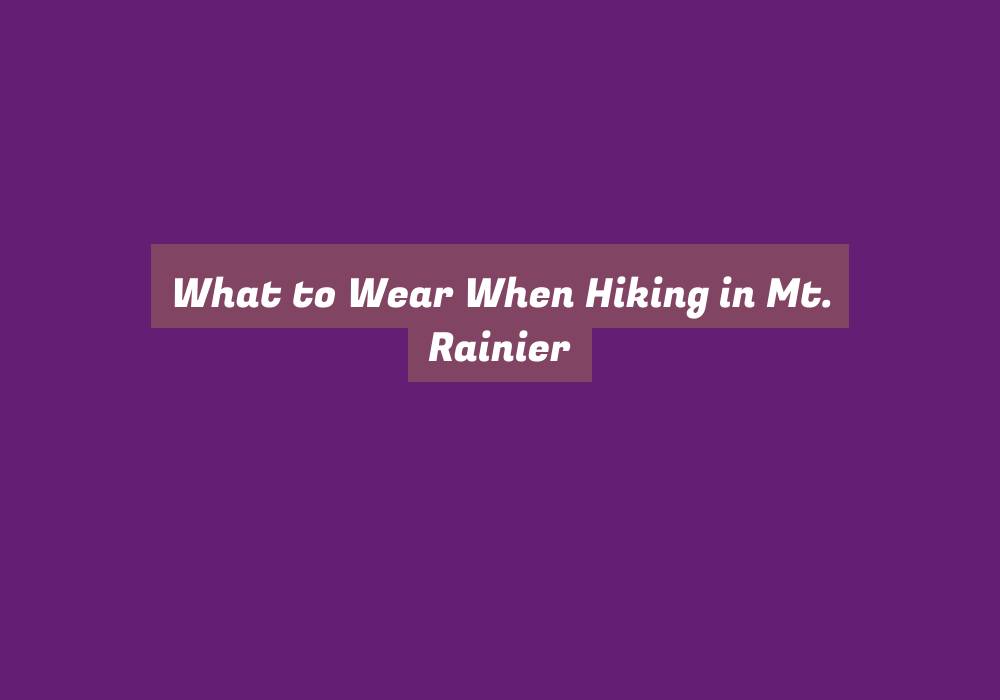Mt. Rainier National Park is located in Washington state and is home to the tallest mountain in the Cascade Range. Planning what to wear when hiking in Mt. Rainier is important, as weather conditions can change rapidly and temperatures fluctuate greatly. This article provides a detailed guide on selecting proper hiking attire and gear for a safe and enjoyable trek at Mt. Rainier.
Checking the Weather Forecast
Before packing for a Mt. Rainier hike, it’s essential to check the weather forecast. Mt. Rainier has variable weather patterns due to its high elevation. Temperatures typically range from 30-80°F in summer and 20-50°F in shoulder seasons. Sudden snowstorms, rain showers, and high winds are also possible. Monitoring forecasts will help determine appropriate clothing and equipment.
Summer Hiking (July-September)
Summer sees the mildest and driest conditions at Mt. Rainier. Daytime highs average 65-70°F at Paradise (5,400 feet) and can reach 80°F on sunny days. Overnight lows drop to around 40°F. Afternoon thundershowers are common.
Spring & Fall Hiking (May-June & September-October)
In spring and fall, average highs at Paradise are 50-60°F, with lows around freezing. Conditions are highly variable, alternating between sunny days and snow/rain showers. September still brings a risk of summer thunderstorms.
Winter Hiking (November-April)
Winters are cold and snowy. Daytime highs peak just above freezing, while lows plummet below zero. Frequent snowstorms dump several feet of snow. Traction devices, snowshoes, or skis are required for winter hiking.
Layering
Layering clothing is the best way to prepare for Mt. Rainier’s variable conditions. Wearing several breathable layers allows you to adjust your level of insulation. As you heat up hiking uphill, you can shed layers to stay cool. Then add layers back as you cool down.
Base Layer
- Purpose: Wicks moisture away from the skin
- Materials: Merino wool, synthetic (polyester, nylon)
- Examples: Long underwear, t-shirt
Mid Layer
- Purpose: Provides insulation from the cold
- Materials: Fleece, down
- Examples: Fleece jacket, down sweater
Outer Shell Layer
- Purpose: Blocks wind and rain
- Materials: Waterproof/breathable fabrics like Gore-Tex
- Examples: Waterproof jacket, rain pants
Recommended Clothing
Here are some hiking clothing essentials to wear in the various seasons at Mt. Rainier:
Shirts
- Synthetic or merino wool t-shirt or long sleeve shirt
- Fleece jacket
- Puffy down insulated jacket
Pants
- Hiking pants: Nylon, quick-dry fabric
- Fleece pants: For added warmth
- Rain pants: Waterproof outer layer
Socks
- Wool hiking socks: Cushioned, warm, and moisture-wicking
- Liner socks: Prevent blisters by wicking moisture
Undergarments
- Synthetic boxer briefs and sports bras: Moisture-wicking and quick-drying
Accessories
- Sun hat: Protects from UV rays at high elevation
- Buff/neck gaiter: Keeps sun off neck and retains warmth
- Lightweight gloves: Fleece or softshell material
- Warm hat: Wool or fleece
Outerwear
Your outermost layer should block precipitation and wind. Choose waterproof, breathable rain jackets and pants. For winter hiking, also bring an insulated parka rated to at least 0°F.
Rain Jackets
Look for these features in a rain jacket:
- Waterproof and breathable fabric like Gore-Tex
- Fully seam-sealed construction
- Storm hood that fits over a helmet
- Zippered pit zips for ventilation
- Drawcord hem and adjustable cuffs
Insulated Winter Parkas
For winter hiking, key parka features include:
- Goose or synthetic down insulation
- Windproof outer shell fabric
- Insulated, removable hood
- Hand warmer pockets
- Adjustable hem and cuffs
Footwear
Proper footwear prevents injuries and keeps feet dry and warm. Consider these hiking shoe/boot features based on conditions:
Summer Hiking Shoes
- Low cut for mobility
- Breathable mesh or leather uppers
- Grippy outsole with deep lugs
- Waterproof membrane like Gore-Tex
All-Season Hiking Boots
- Mid to high cut for ankle support
- Waterproof-breathable membrane
- Insulated uppers (200-400g insulation)
- Rigid shank for stability
- Toe protection from rocks
Winter Mountaineering Boots
- Insulated to 400g+ for subzero temps
- Crampon-compatible rigid soles
- Gaiters to keep out snow
No matter the boot type, make sure to break them in before your hike to prevent blisters. Many trails at Mt. Rainier require crossing streams, so waterproof footwear is a must. Bring extra socks for added warmth and to change out if your feet get wet.
Other Gear Essentials
In addition to proper attire, these items complete your Mt. Rainier hiking kit:
- Backpack (25-50L)
- Trekking poles for stability
- Headlamp for dark trails and emergencies
- Sunglasses to prevent glare
- First aid kit with blister care
- Bear spray for wildlife encounters
- Map and compass for navigation
- Fire starter kit (lighter, matches, tinder)
- Extra food and water
- Emergency blanket and shelter system
Double-check all gear before packing and adjust your kit based on weather forecasts. Adequate preparation makes for an enjoyable and safe hiking experience on Mt. Rainier.
Recommended Clothing by Season
This table summarizes recommended clothing items to wear for Mt. Rainier hiking in each season:
| Summer | Spring/Fall | Winter |
|---|---|---|
| Moisture-wicking t-shirt | Long sleeve base layer shirt | Thermal base layer top |
| Hiking pants | Insulated hiking pants | Softshell mountaineering pants |
| Lightweight fleece jacket | Midweight fleece jacket | Expedition-weight down parka |
| Waterproof rain jacket | Waterproof rain jacket | Hard shell mountaineering jacket |
| Lightweight gloves | Midweight gloves | Heavyweight insulated gauntlet gloves |
| Brimmed hiking hat | Fleece beanie | Balaclava and insulated winter hat |
| Hiking shoes | Waterproof hiking boots | Insulated mountaineering boots |
| Short socks | Mid-weight wool socks | Thick wool mountaineering socks |
Additional Tips
- Pack clothing that dries quickly in case you get wet
- Bring extra layers for warmth during stops
- Avoid cotton, which retains moisture and chills you
- Wear breathable base layers to wick sweat
- Guard against sun exposure on snow and at high elevation
- Carry gear in a way that doesn’t restrict motion
- Have emergency extras of critical items like socks or a parka
Conclusion
Preparing proper apparel and gear makes hiking Mt. Rainier safer and more enjoyable. Research the weather and trail conditions. Layer moisture-wicking, insulating clothes. Have waterproof, sturdy footwear. Adjust your kit to carry enough supplies without weighing you down. With the right clothing and essentials, Mt. Rainier’s stunning alpine environment can be experienced year-round. Just take care to plan ahead and dress accordingly.
Frequently Asked Questions about Hiking Apparel for Mt. Rainier
What types of clothes should I wear hiking in Mt. Rainier National Park?
It’s best to wear lightweight, breathable layers that can be added or removed as conditions dictate. Synthetic and merino wool fabrics that wick moisture are recommended. Bring items like moisture-wicking base layers, fleece mid-layers, and a waterproof/breathable outer shell.
What are the best shoes for hiking Mt. Rainier?
Waterproof hiking boots with ankle support, sturdy soles, and good traction are ideal. For winter, insulated mountaineering boots with stiff soles for crampons are necessary.
Do I need special equipment for hiking Mt. Rainier?
Trekking poles aid stability on steep trails. Other essentials are a bear spray, map/compass, sun protection, first aid kit, headlamp, and enough food/water. Snowshoes or crampons are needed in winter.
How should I dress for summer hiking at Mt. Rainier?
In summer, wear lightweight, breathable clothes like synthetic shirts and hiking pants. Bring insulation like a fleece and have a waterproof outer layer for storms. A hat and sunglasses are recommended.
What clothes are best for spring hiking at Mt. Rainier?
Spring weather varies, so wear layers like long sleeves and fleece along with waterproof jackets. Gloves and beanies guard against chillier temps and snow showers.
What gear is best for winter hiking at Mt. Rainier?
Bundle up in wool base layers, thick insulated jackets and pants, balaclava, goggles, and heavy waterproof shell mittens. Use mountaineering boots, microspikes, or snowshoes. Bring emergency items like a bivy sack.
Should I wear wool or cotton layers hiking Mt. Rainier?
Avoid cotton, which absorbs moisture and chills you when wet. Wool and synthetics like polyester that wick moisture away from the skin are better choices.
How many upper body layers should I wear hiking Mt. Rainier?
A good layering system is 3-4 upper body layers – a base layer, insulating mid-layer, windproof softshell, and waterproof hardshell jacket. Adjust what you wear based on exertion and conditions.
What type of socks are best for hiking Mt. Rainier?
Wool hiking socks insulate feet and wick moisture. Some hikers also wear a thin liner sock underneath to prevent blisters. Bring extra pairs in case socks get wet.
Should I bring rain pants for Mt. Rainier hikes?
Rain pants are recommended even for summer, as brief showers can happen. They also block the wind when stopping. Look for waterproof, breathable models that allow ventilation.
What should I wear hiking Mt. Rainier in winter?
For winter hiking, wear synthetic or Merino wool long underwear, softshell mountaineering pants, thick insulated parka, heavy gloves, balaclava, goggles, and insulated waterproof boots.
Is it better to wear fleece or down jackets hiking Mt. Rainier?
Down provides more warmth for its weight but loses insulation when wet. Fleece dries quickly and insulates even when wet, making it a more versatile mid-layer.
What type of jacket is needed for Mt. Rainier winter hikes?
A heavily insulated parka rated to at least 0°F with a waterproof, windproof shell is needed. Models with a removable hood allow you to layer the parka over other garments.
Can I hike Mt. Rainier trails in tennis shoes?
No, sturdy hiking boots with ankle support and traction are required. Shoes lack protection from rough terrain and stream crossings. Waterproof boots help prevent injuries.
Should I pack extra clothes for the Mt. Rainier hikes?
Yes, carry backup insulating layers, socks, gloves, and other critical items in case the ones you’re wearing get wet. Extra clothes can be a lifesaver in inclement conditions.
What is the best way to layer clothes for Mt. Rainier hiking?
Start with moisture-wicking base layers, add insulating mid-layers depending on the temperature, and top with a waterproof/breathable shell. Adjust your layers as you heat up and cool down.
You May Also Like

My name is David James I am an adventurous hiker based in California. Through this weblog, I percentage my passion for exploring nature’s wonders, documenting breathtaking trails and hidden gemstones.



